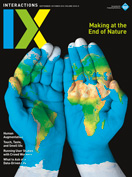Authors:
Gloria Ronchi, Claudio Benghi, Floris Erich, Maša Jazbec, Aisen Chacin, Takeshi Oozu, Sang Yoon, Ke Huo, Karthik Ramani
Pollinators is an interactive sound installation aimed at increasing public awareness of pollinators' decline. Ten interactive birdhouses attached to tree branches made of electric cables are "nesting" different birds; visitors are invited to trigger their calls using a smart phone or tablet. The wooden birdhouses incorporate speakers and amplifiers; the control system includes an Arduino, a Rasperry Pi as a DHCP and Web server, a wireless access point, and bespoke software to allow real-time interactions. This installation reminds us that nature needs our help and invites people to take simple, practical actions to reverse this negative trend.
http://www.aether-hemera.com/Work/Detail/Pollinators
Gloria Ronchi, Aether & Hemera
[email protected]
Claudio Benghi, Northumbria University
[email protected]
 |
Visitors use mobile devices to trigger the calls of "nesting" birds. |
idMirror is an art project that investigates how social networks and emerging mobile technologies have forever changed the perception of human identity. Our research is about how human beings are constructed—how they perceive things in the world, how they interact with the world, and how they are part of the larger whole. The installation consists of two components: the idMirror devices and the idMirror projection. The idMirror devices are tablets embedded in a handle-mirror shell. The idMirror projection is a processing application running on a PC. idMirror was shown at Ars Electronica 2015 and CHI 2016.
http://www.masajazbec.si/?p=408
https://www.youtube.com/watch?v=mo1oXyKlGkM
Jazbec, M. and Erich, F. Investigating human identity using the idMirror interactive installation. Proc. of the 34th Annual ACM Conference on Human Factors in Computer Systems. ACM New York, 2016.
Floris Erich, University of Tsukuba
[email protected]
Maša Jazbec, University of Tsukuba
[email protected]
 |
idMirror questions how identity is perceived in the age of social media and mobile devices. |
IrukaTact is an open source underwater glove that translates ultrasonic range-finding data into haptic feedback. Inspired by dolphin (iruka in Japanese) echolocation, this system detects underwater topographies, assisting in the location of sunken objects in flooded areas. Micro-pumps on the glove send haptic signals to the wearer's fingertips by propelling water of varying pressures. Our feedback method extends current haptic technologies by providing hybrid actuation, including pressure and vibration underwater, while preserving the wearer's natural ability to grasp objects. IrukaTact has many potential applications beyond underwater echo-haptic location, such as in new interfaces for virtual object simulation in aqueous environments.
http://aisencaro.com/iruka.html
Chacin, A.C., Oozu, T., and Iwata, H. IrukaTact: Submersible haptic search glove. Proc. of the 10th International Conference on Tangible, Embedded, and Embodied Interaction. ACM, New York, 2016, 392–397.
Aisen C. Chacin, University of Tsukuba
[email protected]
Takeshi Oozu, University of Tsukuba
[email protected]
 |
An underwater glove with haptic feedback inspired by dolphin echolocation. |
TMotion is a self-contained 3D input device that enables spatial interactions around a mobile device using an enhanced magnetic-sensing technique. Moving the stylus around the mobile device produces continuous 3D position tracking data in real time. Example applications that highlight TMotion's interaction capabilities include spatial tangible measurement, mid-air menu control, and mobile AR input. As 3D mobile interfaces develop, there is an increasing need for better methods to handle and exploit richer user inputs. We envision that a real-time 3D mobile input device like TMotion will fulfill these requirements.
https://www.youtube.com/watch?v=pWuq5H5kyAg
Yoon, S-H. Huo, K., and Ramani, K. TMotion: Embedded 3D mobile input using magnetic sensing technique. Proc. of the 10th International Conference on Tangible, Embedded, and Embodied Interaction ACM, New York, 2016, 21–29.
Sang Ho Yoon, Purdue University
[email protected]
Ke Huo, Purdue University
Karthik Ramani, Purdue University
 |
TMotion enables real-time 3D position tracking with an existing mobile device. It supports both discrete and continuous interactions in expanded interaction volume. |
 |
A mobile AR environment is a good fit for utilizing 3D mobile interaction behind the device. |
 |
Spatial tangible interaction and mid-air menu control provide above-the-device interaction capability with 3D mobile input. |
©2016 ACM 1072-5220/16/09 $15.00
Permission to make digital or hard copies of all or part of this work for personal or classroom use is granted without fee provided that copies are not made or distributed for profit or commercial advantage and that copies bear this notice and the full citation on the first page. To copy otherwise, to republish, to post on servers or to redistribute to lists, requires prior specific permission and/or a fee.
The Digital Library is published by the Association for Computing Machinery. Copyright © 2016 ACM, Inc.








Post Comment
No Comments Found